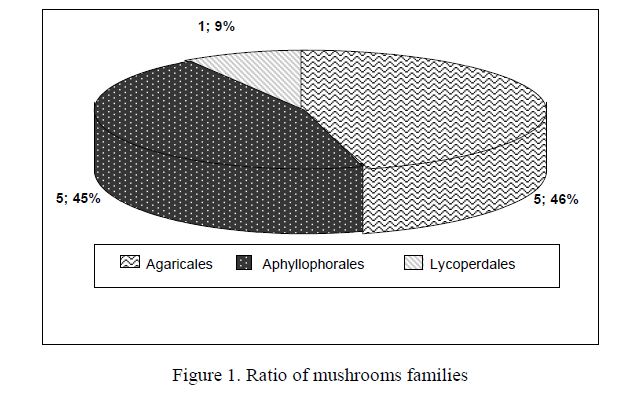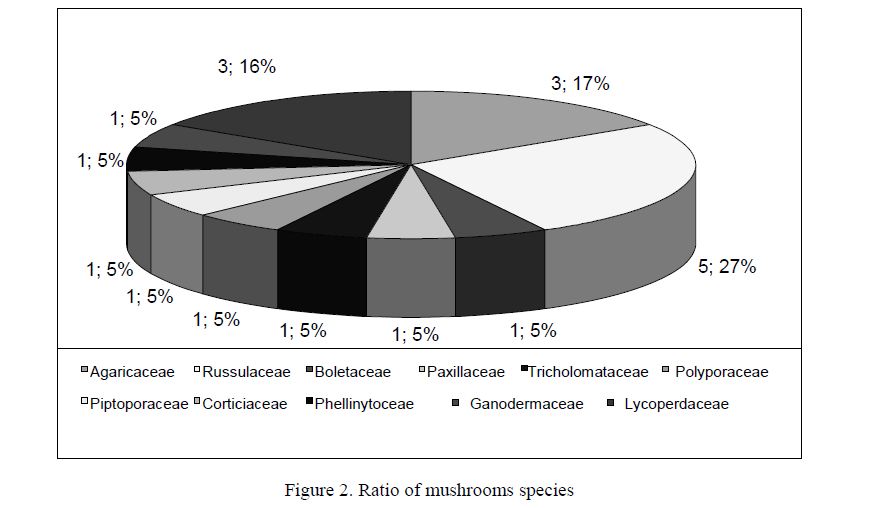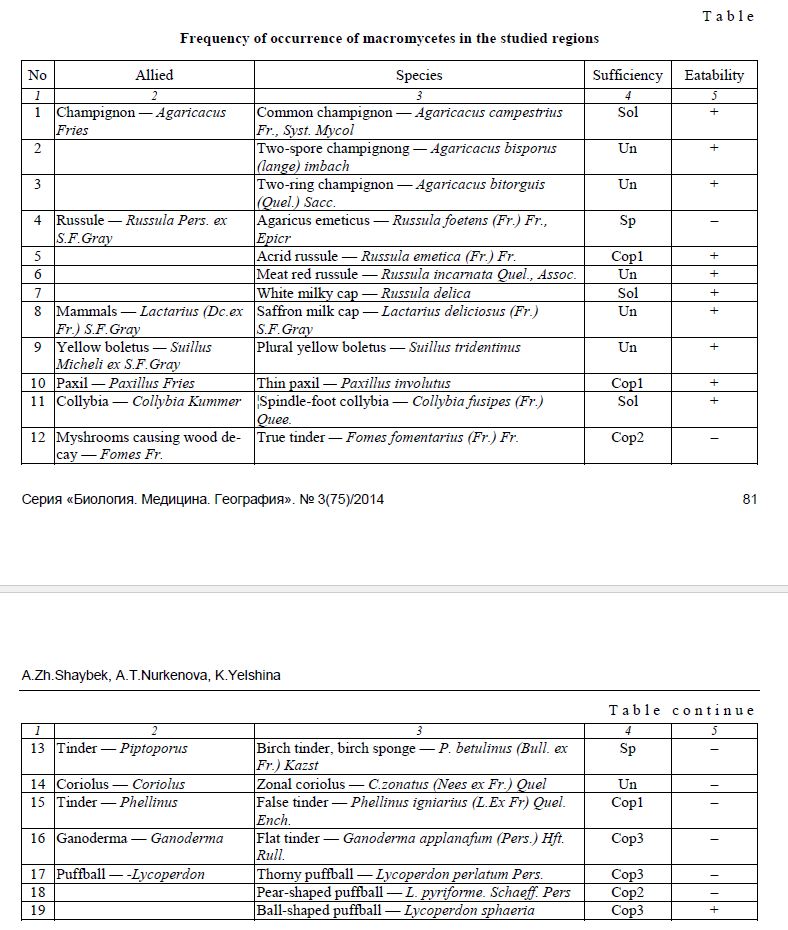The work purpose in the aim of preservation of biological diversity, possible full research of fund of plants is one of main objectives of modern botanical science. During experimental research was put tasks to define specific structure of mushrooms, to reveal their biogeographical distribution and a bioecological state. Work is directed on studying of biomorphological and ecological conditions of the mushrooms meeting in a neighborhood of the settlement of Bakhta of the Karkaralinsky area.
For the purpose of preserving biological diversity the possible complete studying of the plants stock is one of the basic problems of modern botanic science. The defining of the structure of certain species of plants in a certain place, revealing their geographic spreading takes a special place on the development of botanic science. A special group of such organisms there refer mushrooms.
Since most mushrooms are exclusively rapidly multiplying on the continent, there a lot of them in nature. In nature, in man's everyday life mushrooms serve in different ways. They are not only replicators but form a lot of biologically active things, vitamins. On the whole mushrooms take an important place in nature and man's life; apart from being used in meals they are also considered an agent of various infectious diseases. They have their share in the forest biocenose, people's medicine, food industry.
Our work deals with studying bio-morphological and ecological states of mushrooms that are met in the vicinity of the Bakhty settlement of the Karkaraly district.
The work for studying mushrooms is directly connected with the history of botanic expeditions. If at the initial stage mushrooms were gathered on the way within special expeditions on the plants of the highest species, later on, owing to special expeditions there were gathered a lot of mushrooms referring to various groups. As a result of studying there were defined mushrooms aspects in the forest biocenose, pharmacognosy, people's medicine, forensic medicine, industry, microbiology. Beginning from the second quarter of the ХХ century there began to be carried out detailed planned studies [1].
In these expeditions there took part well-known scientists-mycologists of Kazakhstan B.K.Kalymbetov, S.R.Shvartsman, M.G.Vasyagina, N.M.Filimonova, Z.M.Byzova, I.N.Golovenko, E.A.Baygulova, N.F.Pissareva, M.Tartenova, E.A.Daulbayeva, N.Kazhiyeva, N.M.Leonova, B.I.Kravtsev, M.N.Kuznetsova, R.Alimkulova, G.A.Nam. A.F.Meshcheryakova and others. Of course, in spite of the scaled character of studies, the materials collected within the expeditions cannot be considered sufficient. Firstly, all places of the region were not studied rather thoroughly. Secondly, in connection with that a lot of mushrooms grow according to the season conditions the time of expedition cannot cover various season conditions [2].
However, the collected in these years materials permit to understand mushrooms diversity and belonging to various ecological groups rich from the point of view of flora.
In Kazakhstan a great contribution in the development of mycology was made by B.K.Kalymbetov and S.R.Shvartsman, as well as their apprentices M.Vasyagina, Z.Byzova, S.A.Abiyev, B.D.Yermekova, ZhZh.Kukentayeva, S.K.Imankulova, N.Filimonova [3].
The studies Bakhty vicinity is located in the northern part of the Karkaraly district of the Karaganda region. The relief is complicated by inter-top valleys, stream canals, ground waters that go to the surface of the earth breaking ravines, lake pits. Hard mining formations outcrop on the earth surface in the form of rocks, randomly spread pilled hills. Small hills, ravines and separate mountains broken and smoothed on the valley surface stand alone. A smooth steppe region is used for seeding and pastures. The wermuth steppe, green grass of various species in the vicinity of the rivers Nura, Shiderty, Kulanotpes, Yessil are used for haymaking. The east part of the territory presents low mountains consisting of small hills with elements of high-altitude zone. The average height of Bakhty mountain is 1000-1300 m and consists of Abyz, Taldybay and Sholakaiyn [4].
Depending on the plant cover the Bakhty region refers to the steppe region and region with dry steppe. The pant world has original regional features: firstly, the plant layer transits from valleys to mountains with the growing number of plant species; there are a lot of rains after which there is evaporation. Therefore the plant layer decreases from the north to the south.
On the banks of the rivers North Terisakkan, Sherubay-Nura and Sarysu there are developed plants of the desert steppe (xerophytes). These plants are drought resistant and consist of several species of cereals and wormwood. There are growing mat-grass, wormwood, meadow grass, fescue, arrow grass.
The group of wormwood on the slopes of small hills there make various species of sagebrush. On the slopes of small hills there is also mat-grass, pea shrub, spirea.
Near the rivers, lakes in the meadow-salted soils there grow various puccinellias, water moss. For saline soils there are characteristic bur grass, orach, etc. In the mountain desert the plant layer consists of rare wormwoods. On the region territory there are rare bushes — spirea, haw, brier. On the stream canal there are forests consisting of willows and jidda. In connection with the river drying and the desert forming the state of trees became worse [4].
Deciduous and coniferous forests are growing only at the low mountains feet. Small deciduous forests consist of aspens and white birches. They perform an important protective function in this vicinity [4].
On the whole gathering mushrooms and making herbarium are performed using generally adopted methods. When gathering mushrooms it is necessary to take into account the original ecological, geographical and other features of each vicinity
Making herbarium of the mushrooms growing in the semi-desert place of the Karaganda region is performed by the common method (see Mushrooms reference books: Life of plants. V. ІІ. М., 1976; Stepano-va N.T., Mukhin V.A. M., 1979; Dudka, 1987; Mushrooms of the USSR, 1980; Mushrooms, 1984; Helmut and Renate Grunert, 2002; Flora of spore plants of Kazakhstan, 1985; Samgina D.I., 1985; G.I.Serzhanina, 1984; P.A.Saccardo, 1887; Moser, 1978; E.Lange, 1936; R.Keehner, H.Romagnesi, 1974 [5].
The defining of the systematic mushrooms vicinity is realized using different authrs' reference books and Flora of spore plants of Kazakhstan [5, 6].
In the course of studying macromycetes of the region there were collected materials from the vicinities of tree planting of Bakhty and mountain region Kent. By the available materials there are carried out studies in the laboratory conditions and systemized. There were gathered 24 species of mushrooms, divided into groups. Defined the 1 class mushrooms, point 1, point 2, row 3, 11 of one breed, 12 of the other breed, 19 species.
When classifying all macromycetes met in mountain vicinities, forest territories Kent, Bakhty, the class of basidiomycetes is divided into 3 large rows. They are: Aphyllophorales, Agaricales, Lycoperdales.
The ratio of the families of generally defined mushrooms is presented in Figure 1. Among the known Agaricales (700 species) in the studied zone 11 species made 1.57 %. 5 species defined from the row of Aphyllophorales (270 species) — 1.85 %, 82 species of Lycoperdales in our region made 3 species or

Figure 1. Ratio of mushrooms families
In Figure 1 it is clear that in the row of Agaricales there are 5 allied, in the row of Aphyllophorales there are 5 allied, and in the row of Lycoperdales there is 1 allied species.
The ratio by the type of classified families of certain mushrooms is presented in Figure 2. There are the following most often met species: (Agaricaceae Fries — 3 species, Russulaceae Roze — 5 species, Lycoperdaceae — 3 species.

Figure 2. Ratio of mushrooms species
According to the systematics of macromycetes of the studied regions and the Table of biological features, and taking into account characteristic features of 11 families, in the Table there are presented the results of the studies.
Table
Frequency of occurrence of macromycetes in the studied regions

Among them to the group of eatable mushrooms there refer 11 species. In connection with these species frequency of occurrence there are met: Lycoperdon sphaeria, Lycoperdon perlatum, Ganoderma applanafum — Cop3 great lots, L. pyriforme — Cop2 middle lots, Russula delica Sol — little and R. emetica Cop1 — rather many.
The following representatives are considered the dominant species: Russula emetica (Fr.) Fr., Fomes fomentarius (Fr.) Fr., Lycoperdon sphaeria, Lycoperdon perlatum, Lycoperdon pyriforme, Ganoderma applanafum.
Among little eatable there are selected 8 species: Agaricacus campestrius Fr., A.Bisporus, A. bitorguis (Quel.) Sacc. Russula emetica (Fr.) Fr., R.incarnata — Sol; Russula delica, etc.
On the whole of 19 defined species only 11 species are eatable. To the allied mushrooms met as endosporic, such as Lycoprdon there are defined 3 species.
By the results of the study there can be made the following conclusions:
There were gathered 24 representatives of the mushrooms in the Bakhty vicinity of the Karkaraly district; the defined mushrooms were classified into 3 groups, 11 families, 12 allied, 19 species.
In the reference the Russula delica species that refers to the Russulaceae family found in the Kent, Bakhty of the Karaganda region, and the Agaricus bitorguis species that refers to the Agaricaceae family there are no information of that they are met in Kazakhstan. The other species of the allied mushrooms are found only in the south regions of Kazakhstan.
There are the following 3 allied mushrooms that are met a lot: Agaricaceae Fries — 3 species, Russulaceae Roze — 5 species, Lycoperdaceae — 3 species.
To the group of eatable mushrooms there refer 11 species, 8 species are uneatable.
All the defined mushrooms exist in mesophyte conditions. The following species are dominant: Russula emetica (Fr.) Fr., Fomes fomentarius (Fr.) Fr., Lycoperdon sphaeria, Lycoperdon perlatum, Lycoperdon pyriforme, Ganoderma applanafum.
References
- Botanic studies in Kazakhstan,Аlma-Ata: Nauka,
- Kalymbetov B.K. Mycological flora of the Ili Alatau, Alma-Ata: Nauka,
- AbdrakhmanovО.А.Systematization of the lower tier plants, Almaty,
- Karaganda region: Encyclopedia, Almaty: Atamura, 2006, 584 p.
- Laboratory practicum in mushrooms and mosses, Moscow,
- Flora of spore plants of Kazakhstan, Alma-Ata: Nauka, 1979-82, 1-15.